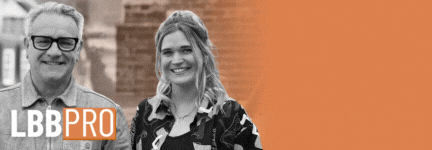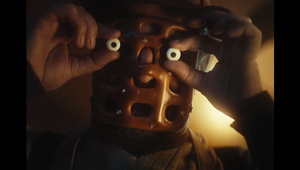
The Directors: Kosta

Kosta is a director whose commercial work effortlessly spans genres, exploring endless visual and narrative possibilities with the ease of a natural storyteller. At the age of 12, Kosta began his career apprenticing his DOP father on set. Later, after graduating from the College of Dramatic Arts in Belgrade, his love of the film medium led him to become a feature film DOP and then an accomplished commercial director.
His highly unique personal style and technical prowess continue to define his inventive and diverse body of work for clients including Coca-Cola, T-Mobile, Honda, and Nescafe.
Name: Kosta
Repped by: Emerald Pictures, US/ Nouri Films, Spain
What elements of a script sets one apart from the other, and what sort of scripts get you excited to shoot them?
It really depends. It’s less about a specific genre and more about the freedom it offers me to experiment. Looking back at some of my recent projects there are a few elements that stand out - such as nonlinear structure, boldness, quirky details, and visual play. Since I started in fashion as a photographer I have always liked to mix these elements.
Storytelling is key in any work that I do, of course; yet, since my language is quite visual, and I tend to express myself with images rather than words, any script that supports that is up my alley. I love an eclectic structure, something unexpected, and rhythm-driven.
How do you approach creating a treatment for a spot?
It is dependent on the script and the brief. The brief is a crucial piece, in order to feel out where the agency’s limits are - how far they are prepared to go.
The process itself depends on the script. I always feel that the script needs to be deconstructed, or turned upside down so that you arrive at a new beginning. At that point, your mind is fresh and clear to make the most of it.
The treatment represents the start of the true collaboration and it works to provoke and challenge. Is the agency ready to go for something more daring or drastic? If it’s an agency that I know, then I may get very precise, because I know who I’m working with and what their process is. I love doing treatments where the main ideas are there, but there is room to experiment. The treatment is the moment where there is no pressure. It’s the stage of pre-production where you are the most open-minded, so I try not to limit myself.
Sometimes I get down into the details and draw a precise shooting board. Sometimes I do a website or a small video presentation. With website treatments, you have the freedom to make it interactive which people tend to like. Other times, I try not to get caught up with details and miss the big picture. The most important thing is to not be stuck to the script and be willing to try things from another angle. You have to make the case-by-case decision on whether to risk it and throw some ideas out there that they may not like or to play it safe. In my experience risk is usually the best approach.

If the script is for a brand that you're not familiar with/ don’t have a big affinity with or a market you're new to, how important is it for you to do research and understand that strategic and contextual side of the ad?
It’s not important for me at all. The most important considerations are almost always laid out pretty well in briefs, so I tend not to focus too much on doing my own research. The research I do on my own could possibly send me in the wrong direction. In fact, I think knowing too much of that detail can sometimes get in the way of the creative process, almost becoming a form of self-censorship. I trust the agency or brand to tell me what I need to know.
For you, what is the most important working relationship for a director to have with another person in making an ad? And why?
As I mentioned, my background is in photography and most of the time I shoot my own films. That is why the most valuable relationship I develop during any project is probably the one with my producer. My producer is someone who is there to keep me in balance. In my case, it’s my producer who tells me where the limits are, is on my side if I need to fight for a creative element, and to push me. That’s how I like it.
What type of work are you most passionate about - is there a particular genre or subject matter or style you are most drawn to?
I like scripts that allow me the freedom of interpretation, to play with visual metaphors, and that are propelled by a sort of rhythm. I prefer it not to be a single specific genre on its own, but rather a mix of several. I love to shoot dance sequences, eclectic visuals, and disparate things you wouldn’t think would work together, but then work perfectly. When you’re stuck with the same thing over and over again, you lose your edge and become boring. That’s why I love to flow from music videos to fashion, miniatures to stop motion, or even optical illusions.
What misconception about you or your work do you most often encounter and why is it wrong?
With so many high-speed shots on my reel, a number of tabletop projects come in for me that I am not as excited about because they don’t challenge me as much creatively. While I do use high-speed shots, whether it’s with food or liquids, I use them as part of the story I am telling. They become yet another tool I use to visually tell a story.
Have you ever worked with a cost consultant and if so how have your experiences been?
It is pretty standard practice these days; however, I always have a buffer between me and them, so it doesn’t usually affect me all that much. I typically have a good experience because they are there to keep the balance and it helps you to think very carefully about what you need and to become more efficient in production.
What’s the craziest problem you’ve come across in the course of a production – and how did you solve it?
Once I had a real shark appear in the frame - out of nowhere - while almost the entire crew was standing waist-deep in the water! We couldn’t solve it - thankfully it just left. Every shoot inevitably has some story, but this one was very memorable.
How do you strike the balance between being open/collaborative with the agency and brand client while also protecting the idea?
Since I have my hands in almost everything on a set it’s important to me to have a strong collaboration with the agency. I see that relationship as give and take. The most important aspect is the trust being built in the process. That said, you do need to be passionate about the project and not let certain things go, to protect the idea.
I will say it’s very different in Europe than in the States. In Europe, you have two meetings, the Pre Pro Meeting and the pre-PPM. Before the Pre Pro, the agency doesn’t know anything about your direction. You spend 3-4 weeks prepping something that might be completely wrong in their opinion. In the States, it’s much more relaxed because you go through everything step by step with them along the way. You don’t have that extremely stressful meeting where everything could get rejected.
What are your thoughts on opening up the production world to a more diverse pool of talent? Are you open to mentoring and apprenticeships on set?
I very much support opening things up to new perspectives, particularly those we haven’t heard from before. On every shoot, I have two, sometimes three, units, which gives me the opportunity of bringing in new talent. It may be a bit more tiring to do so, but it’s also quite rewarding and often successful. A different perspective, bringing something new to the mix, is always a good idea.
How do you feel the pandemic is going to influence the way you work in the longer term? Have you picked up new habits that you feel will stick around for a long time?
I don’t like Zoom and hope it is not here to stay. If you don’t already know the people you’re working with, they can’t necessarily have full confidence in you from a virtual meeting. It’s easier to build that trust in-person. I look forward to being able to return to that.
Your work is now presented in so many different formats - to what extent do you keep each in mind while you're working (and, equally, to what degree is it possible to do so)?
You can’t shoot 9x16 and 16x9 in the same frame, at the same time. So, it’s a compromise and it doesn’t always end up being the best result it could have been. Something ends up being sacrificed. I prefer to have a separate unit capture the digital footage. That is one nice thing - when there is a digital unit we can use them as a 2nd Unit. The cost controllers want you to do everything instead of having a separate digital unit. In my opinion, it’s not good and I don’t like it, but you need to compromise.
What’s your relationship with new technology and, if at all, how do you incorporate future-facing tech into your work?
The most exciting thing about new technologies is learning all about them and exploring the way things can be done with them. Everything is changing at such a fast pace that it almost always represents a challenge, and it’s probably something you’ve never done before. The downside of it is that some tech fades quickly.
I like learning new things - it’s inspiring - but sometimes it just wastes time. I’m not a big fan of doing motion capture stuff and virtual backgrounds. Interactive is very interesting, I’ve done a few things with that. I say, choose your own way.
Which pieces of work do you feel really show off what you do best – and why?
These four represent my most recent phase. I’m not sure if this is what I do best, but for sure it’s what I’m enjoying the most at the moment.
Q2
The task here was to illustrate the basic features of cell phones. I like how it turned out complex, yet clear. Also, I love the music mix.
PINK
TV idents are always fun to watch. I particularly like how one thing leads to another, scene by scene.
ACTIVIA
It’s always challenging working with a song. The grinding rhythm forces you to illustrate almost every word. I think in the end it turned out quite nice.
FOOD NETWORK
Apart from loving to do all these tricks in-camera, I think the visuals are just right for the V.O.













